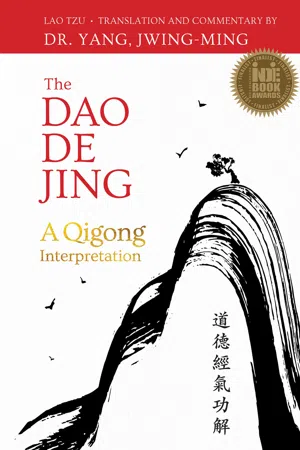
The Dao De Jing
A Qigong Interpretation
Jwing-Ming Yang
- 544 pages
- English
- ePUB (mobile friendly)
- Available on iOS & Android
The Dao De Jing
A Qigong Interpretation
Jwing-Ming Yang
About This Book
This book examines one of the world's most enduring and influential literary works through the timeless art of qigong. In his words, Lao Tzu (or Laozi), author of the Dao De Jing, embodies qigong principles, advocating the cultivation of mind and body. Only when we know qigong can we know Lao Tzu—and only when we know Lao Tzu can we know the Dao De Jing.
Lao Tzu's writing has been read, translated, and discussed around the globe. It deals with principles that transcend time and culture. That is why this ancient text has been reimagined countless times in books on business, relationships, and parenting—but never with a focus on the art of qigong. This makes the Dao De Jing: A Qigong Interpretation unique and indispensible.
Many chapters in the Dao De Jing purely talk about qigong, especially the practices of regulating the body, breathing, mind, qi, and spirit.
Dr. Yang, a renowned author, scholar, and martial artist, devoted decades to researching and writing this book. He interprets and analyzes the 81 chapters of the Dao De Jing. His commentary will bring new insight, inspiration, and depth to your understanding of Lao Tzu's words—and to your qigong practice.
This book includes
- The complete Dao De Jing in English and its original Chinese text
- Dr. Yang, Jwing-Ming's commentary and analysis of each chapter
- Numerous illustrations and diagrams
The Dao De Jing: A Qigong Interpretation is not a book of instruction. It is about the Way—the path before us, in qigong and in life, where what you achieve comes through your own understanding.
Frequently asked questions
Information
Dao Jing (Dao Classic)—Chapters 1 to 37
Note:
CHAPTER 1
Comprehending the Embodiment of the Dao—The Entrance of Dao
General Interpretation
Table of contents
- Cover
- Title Page
- Copyright
- Table of Contents
- Foreword—Dr. Thomas Gutheil
- Foreword—Mr. Charles Green
- Foreword—Dr. Robert J. Woodbine
- Preface—Dr. Yang, Jwing-Ming
- Introduction/Foundation
- Dao Jing (Dao Classic)—Chapters 1 to 37
- De Jing (Virtue Classic)—Chapters 38 to 81
- Acknowledgements
- Dedication
- Appendix: Translation and Glossary of Chinese Terms
- About Lao Zi
- About the Author—Dr. Yang, Jwing-Ming